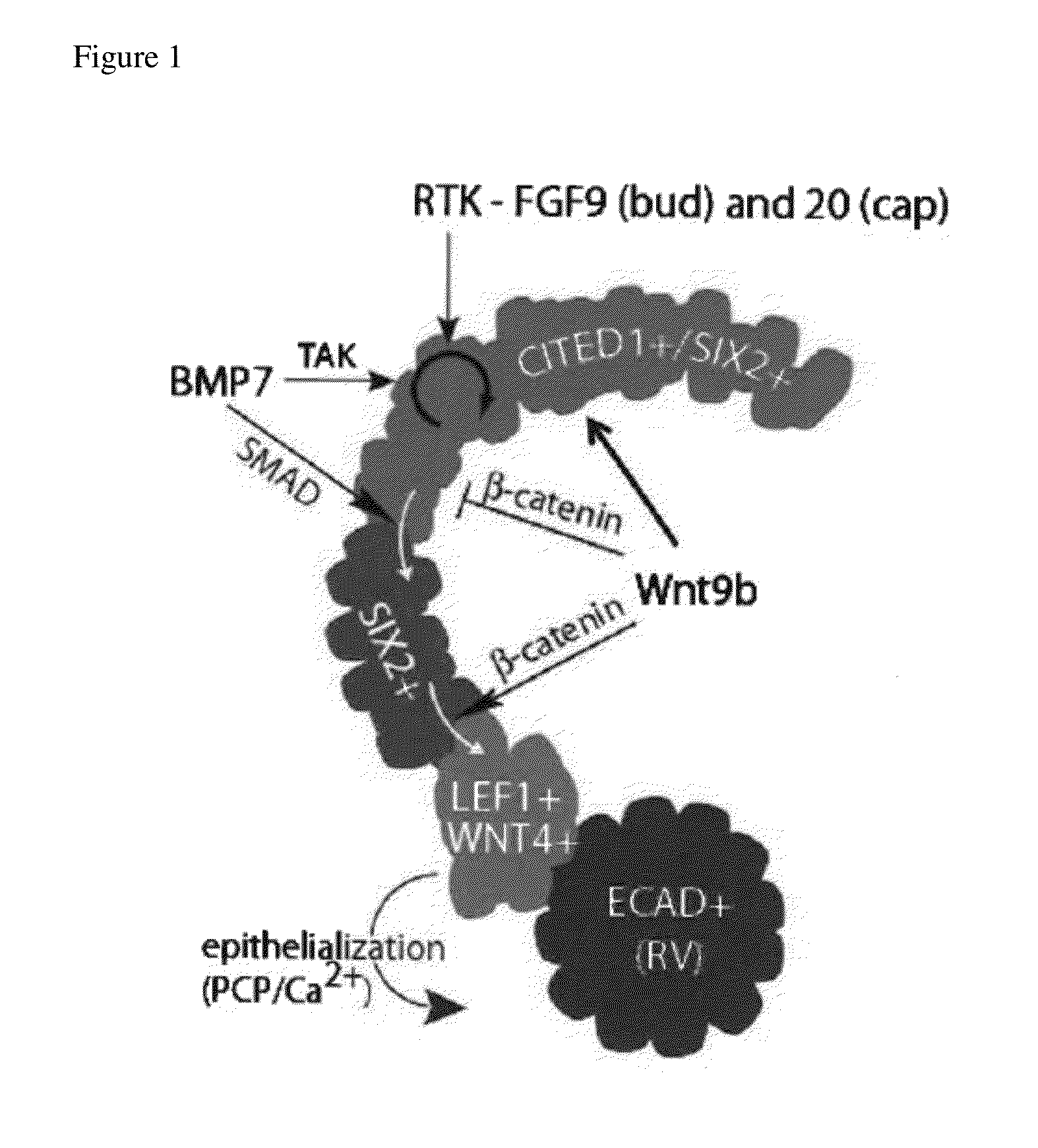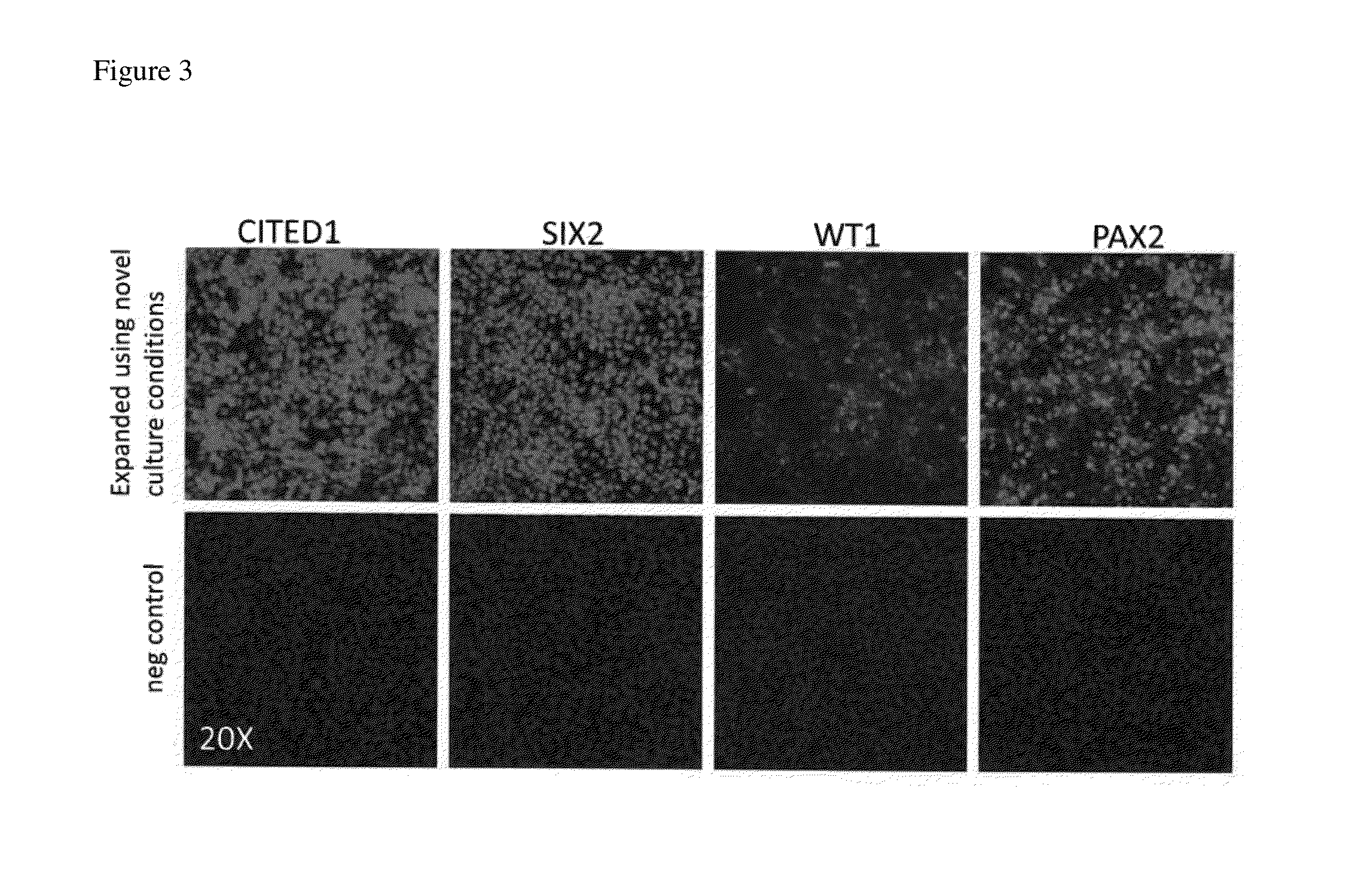Culture conditions for expansion of nephron progenitor cells
a technology culture conditions, which is applied in the field of culture conditions for the expansion of nephron progenitor cells, can solve the problems of relatively modest number of cells that they genera
- Summary
- Abstract
- Description
- Claims
- Application Information
AI Technical Summary
Benefits of technology
Problems solved by technology
Method used
Image
Examples
example 1
Experimental Procedures
[0072]Cell culture. CITED1+ progenitors were purified from NZCs derived from E17.5 kidneys as previously described (Brown et al., 2011b; Brown et al., 2013). CITED1+ progenitors were cultured in monolayer on hESC qualified Matrigel™ coated plates (Corning). For human or mouse passage, cells were dissociated by incubation with TrypLE (Life Technologies) for 2 minutes at 37 C, washed and spun 2× at 300 g in autoMACs running buffer (Miltenyi) prior to resuspension in NPEM as described in Table 1. NPEM is changed every 2 days. Cells were differentiated in aggregate culture with CHIR (3 μM) in medium as previously described (Brown et al., 2013).
[0073]Immunofluorescence and microscopy. Tissue sections, monolayer cultures and aggregates were immunostained as previously described (Blank et al., 2009; Brown et al., 2013). Antibodies were used at 1:100 dilution and include CITED1 (NeoMarkers); pSMAD1 / 5 (Cell Signaling Technology); SIX2 (Proteintech); LEF1 (Cell Signalin...
example 2
SMAD Inhibition with LDN-193189 Retained Nephron Progenitors in the CITED1-Expressing Compartment
[0078]As a starting point for the development of conditions for propagation of nephron progenitor cells, a series of observations on signaling in cap mesenchyme during the terminal stage of nephrogenesis were drawn upon. It was previously shown that BMP7 signaling through the SMAD1 / 5 pathway was required for undifferentiated CITED1+ / SIX2+ progenitors to transition to a CITED1− / SIX2+ state in which they are sensitized to epithelial induction by WNT / β-catenin signaling (FIG. 6A; Brown et al., 2013). In the mouse, cessation of nephrogenesis occurred shortly after birth and this was accompanied by a loss of Cited1+ cap mesenchyme by P2 (FIG. 6B). It was reasoned that SMAD1 / 5 signaling might have increased during the terminal phase of nephrogenesis, skewing the renewal versus differentiation balance and depleting the cap mesenchyme. Immunostaining of mouse kidneys from E17.5 to P2 for activa...
example 3
Developmental Regulators FGF, BMP and WNT were Required for Maintenance, Expansion and Differentiation of CITED1 Progenitors
[0081]To define additional factors that were required for nephron progenitor propagation, past studies were consulted related to signaling in cap mesenchyme (Table 1). It was previously demonstrated that addition of either FGF1, 2, 9, or 20 promoted the maintenance and proliferation of CITED1 progenitors when cultured in monolayer on fibronectin coated wells with keratinocyte serum-free medium (Brown et al., 2011a). However, these cells lost expression of cap mesenchyme markers after 2 to 3 days and died. FGF9 was selected for use in monitoring CITED1 maintenance and proliferation, as it was recently identified as a natural ligand for maintenance of nephron progenitors in vivo (Barak et al., 2012). Heparin was included as it facilitates the binding of FGF9 to its receptor. It was previously shown that BMP activation of the JNK pathway was critical for the proli...
PUM
 Login to View More
Login to View More Abstract
Description
Claims
Application Information
 Login to View More
Login to View More - R&D
- Intellectual Property
- Life Sciences
- Materials
- Tech Scout
- Unparalleled Data Quality
- Higher Quality Content
- 60% Fewer Hallucinations
Browse by: Latest US Patents, China's latest patents, Technical Efficacy Thesaurus, Application Domain, Technology Topic, Popular Technical Reports.
© 2025 PatSnap. All rights reserved.Legal|Privacy policy|Modern Slavery Act Transparency Statement|Sitemap|About US| Contact US: help@patsnap.com



